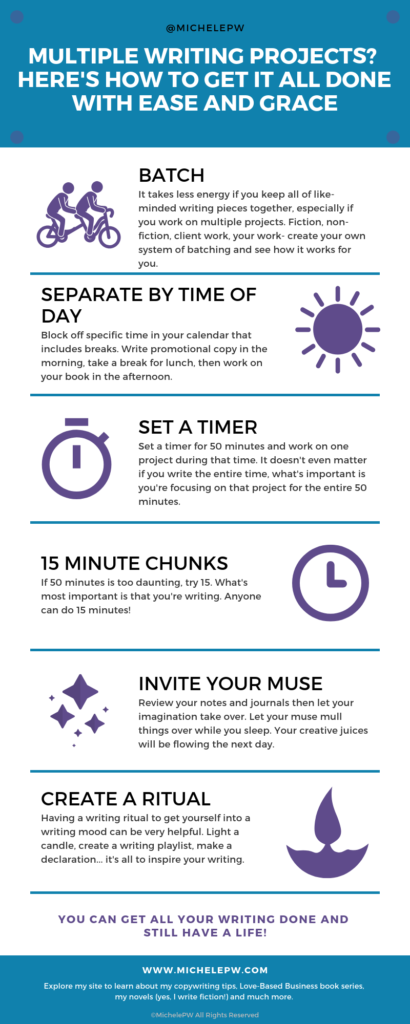As a professional writer who has published multiple books along with maintaining two blogs, it’s not uncommon for me to have to balance multiple writing projects every day. Whether it’s promotional or article writing for myself or my clients, or working on my latest psychological thriller (yes, I write fiction, too), there’s always something that needs to be written.
While you may not have quite as many writing projects on your desk as I do, it’s entirely possible you’re feeling overwhelmed with what you do have on your plate.
Maybe, in your case, you’re trying to figure out how to balance a blog post, a sales page for a new program, and a book your soul is calling you to get out into the world.
So, how do you get it all done? (Without pulling all your hair out, of course.)
Well, below are a five tips I’ve used to help me balance my day, so I’m able to get everything done and still have a life
1. Batch similar projects together.
So, for instance, you may want to separate your promotional writing projects (i.e. sales emails, sales letters, web site updates, etc.) from your content writing projects.
(For myself, I’ll separate even further, putting client projects together and separating fiction from nonfiction activities, but you likely don’t have that many writing buckets.)
Writing a book requires a different mindset than writing a blog post, which requires a different mindset than writing a promotional email, and so forth. It takes less energy, then, if you group your writing pieces together.
2. Separate your writing activities into time blocks.
Once you’ve divided your writing projects into similar buckets, you’ll want to block off specific times in your calendar to work on them. Be sure to include breaks. So, for instance, maybe you want to write your promotional copy in the morning, take a break for lunch, then work on your book in the afternoon.
Having a natural break in the day is a great way to allow your muse time to unwind and switch between writing projects. It’s nearly impossible to go from project to project to project without a break, so building in those break times is important.
3. Set a timer.
If you have a difficult time getting started, try setting a timer for 50 minutes, and work only on that one project during that time. Turn off Facebook and email and have only that specific project in front of you. It doesn’t even matter if you write the entire time—what’s important is that you’re focusing only on that project for the entire 50 minutes.
When the timer goes off, take a break for at least ten minutes, even if you’re in the middle of writing. Your brain needs a rest to keep optimum focus.
Bonus tip: When I’m blocked, I’ve also had some success writing nonsense, even typing “I don’t know what to write” over and over again. Even if what you’re writing is crap, sometimes the sheer fact that you’re typing is enough to kick the brain into gear. Before you know it, you’ll be happily typing away.
4. If 50 minutes is too daunting, try 15.
This comes from my good friend Samantha Bennett, who advocates committing 15 minutes every day to your creative passion project.
If you’re trying to work on a book, for example, this may be a better solution to keep moving the book forward when you feel stuck. Now, the trick is, you have to show up EVERY DAY for at least 15 minutes. It doesn’t matter what you do—you can stare at your outline for 15 minutes. What’s important is to show up.
And, if you’re skeptical about whether this actually works or not, I wrote my entire nonfiction series AND got my novel writing kickstarted using this 15-minute-a-day approach.
5. Give your muse an opportunity to help.
If any of my writing projects are big (such as creating a sales page) I’ll take a few minutes the night before to review all of my notes and think about the project. I might even create a quick outline or jot down any initial impressions. The point is to get the creative juices working.
Your muse will likely mull about your project in your subconscious while you sleep, so when you wake up, you’ll be fresh and full of ideas about what you want to do.
Lastly, you may want to create a writing ritual as well. I talk about writing rituals in my “Love-Based Copywriting System” book, but having a writing ritual to get yourself into a writing mood can be very helpful.
The most important thing you can do is create a writing container that works for you. So, whether that’s using all five of these tips, only a couple or creating your own structure, just make sure it works for you.
And, if you’d like to dig into this topic more, my “Love-Based Copywriting System” book may be the perfect for you.
 No, It’s Not Burnout (And, no, more “self-care” isn’t going to help)
No, It’s Not Burnout (And, no, more “self-care” isn’t going to help) 4 Ways the Love-Based Concept Plays Out in Your Business
4 Ways the Love-Based Concept Plays Out in Your Business What Does it Mean to Have a Love-Based Mission?
What Does it Mean to Have a Love-Based Mission? 3 Keys to Making Money with Your Passion
3 Keys to Making Money with Your Passion Your Step-by-Step Guide to Writing a Book During a Global Pandemic
Your Step-by-Step Guide to Writing a Book During a Global Pandemic
Leave a Reply